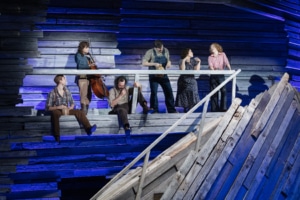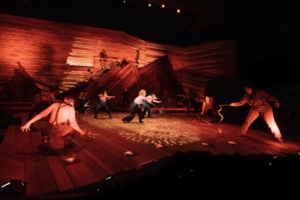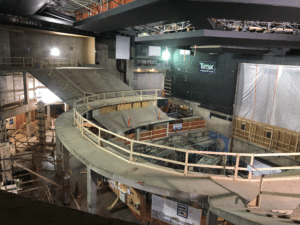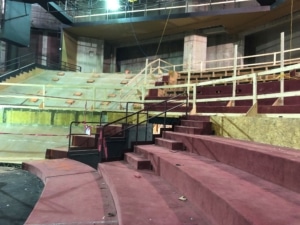DCPA NEWS CENTER
Enjoy the best stories and perspectives from the theatre world today.
Enjoy the best stories and perspectives from the theatre world today.
Recurring climate catastrophes have made all the more plain the urgent need to reduce our carbon footprint in every way, from how we drive our cars to how we power our businesses to, yes, how we make and present live theatre.
But as is the case with anything that requires a fundamental change in how we go about our everyday business, the question about sustainability in the making of live theatre is really how sustainable is sustainability itself. In a field where creative teams shift with each show and no one seems to stay in any one place for long, it can be hard to find people who have the interest and availability to assume long-term responsibility for it.
 “In Colorado, this is a movement in its very first tentative steps,” said DCPA Sound Technician Meagan Holdeman, who has taken on the challenge of creating a united green Colorado theatre community. And she understands that right now, many in the field are either burned out or burning the ends of too many candles to fit saving the Earth into their daily routines. Does it really matter if that compostable cup in the lobby winds up getting tossed down the recycling hole?
“In Colorado, this is a movement in its very first tentative steps,” said DCPA Sound Technician Meagan Holdeman, who has taken on the challenge of creating a united green Colorado theatre community. And she understands that right now, many in the field are either burned out or burning the ends of too many candles to fit saving the Earth into their daily routines. Does it really matter if that compostable cup in the lobby winds up getting tossed down the recycling hole?
In fact, it does.
“Sustainability is always a battle with convenience,” Holdeman said. “The fact of the matter is, the wasteful thing is often the most convenient thing. So how can we change things so that the non-wasteful thing is also the most convenient thing?”
Making live theatre leaves a surprisingly deep carbon footprint, Holdeman said. There are all those lights, all that power, all that paper, all that construction and all that human consumption. The dirty little secret about the making of live theatre, Holdeman said, is that most times, those grand, masterful scenic designs that provide a temporary home for the stories we tell often end up in an alley Dumpster heading for a landfill.
 The most important step toward meaningful change, she said, is the first one. “People tend to think that they need to go all or nothing, and if they can’t do it all right away, they shouldn’t try at all,” Holdeman said. “I really want to get people to start thinking about what little things they can do in their daily lives that are not hugely inconvenient, because then that snowballs. That’s literally how I got to where I am now.”
The most important step toward meaningful change, she said, is the first one. “People tend to think that they need to go all or nothing, and if they can’t do it all right away, they shouldn’t try at all,” Holdeman said. “I really want to get people to start thinking about what little things they can do in their daily lives that are not hugely inconvenient, because then that snowballs. That’s literally how I got to where I am now.”
Because of its place as the largest performing arts organization in the region, Holdeman said the local theatre community is naturally looking to the Denver Center for guidance and example. “And we are not where we need to be yet,” she said frankly.
But the Denver Center has taken some meaningful steps that she hopes become lasting examples. For example, Off-Center’s recent holiday staging of Camp Christmas “was 100 percent powered on renewable solar energy” at the Heritage Belmar Lakewood Park, said Jeff Wong, Senior Sustainability Planner for the City of Lakewood.
 And the set of the DCPA Theatre Company’s current world premiere production of Rattlesnake Kate was constructed using about half reclaimed (meaning not virgin) wood. That’s significant given the size and scope of the massive set imagined by Boulder Scenic Designer Klara Zieglerova, who depicts the vast flatlands of Weld County and the imposing Rocky Mountains largely using 8,000 square feet of what appears to be entirely wood.
And the set of the DCPA Theatre Company’s current world premiere production of Rattlesnake Kate was constructed using about half reclaimed (meaning not virgin) wood. That’s significant given the size and scope of the massive set imagined by Boulder Scenic Designer Klara Zieglerova, who depicts the vast flatlands of Weld County and the imposing Rocky Mountains largely using 8,000 square feet of what appears to be entirely wood.
“For me, the biggest factor for using reused materials came to me from the story itself – absolutely, 100 percent,” said Zieglerova. “When I thought about Kate Slaughterback on the flatlands of Colorado, living off the land, I strongly felt like I wanted to pursue a similar philosophy in my design. But the desire for sustainability was there as well. The world we live in is endangered by how much waste we produce. And when you look at live theatre, it’s upsetting on so many levels how much of what we build just goes to waste.”
 It was during a visit to a sawmill in Niwot to research different native species of Colorado wood that it occurred to Zieglerova that Rattlesnake Kate would be an opportunity to join the green movement. “As I was looking at those scraps, I realized that the building block for the set had to be found wood,” she said. “That felt right to me. I love the texture of the wood and the way it feels. And the way the light looks when it hits an actual, real material.”
It was during a visit to a sawmill in Niwot to research different native species of Colorado wood that it occurred to Zieglerova that Rattlesnake Kate would be an opportunity to join the green movement. “As I was looking at those scraps, I realized that the building block for the set had to be found wood,” she said. “That felt right to me. I love the texture of the wood and the way it feels. And the way the light looks when it hits an actual, real material.”
But there is a practical part of the sustainability equation as well, Zieglerova said. “We try to reuse and recycle everything we can, but sometimes it comes down to economics. Sometimes the cost of storing a set until you might need it again is more expensive than simply buying new materials when the time comes. You have to respect that, especially when you are a non-profit theatre.”
Other considerations: The stage floor had to be made from all-new wood because of the need for a smooth dancing surface. “That’s a safety issue for the actors,” she said. ”We couldn’t have splinters on the floor.” And much of the set’s massive planked wall surface is not wood at all. It is actually heavily treated foam that was cut to look like wood to provide needed weight and stability that wood could not. The problem is, “Of all the plastics, foam is the worst of the worst,” Holdeman said. “Styrofoam is toxic, and it is nearly impossible to recycle.”
 Still, baby steps. The Denver Center’s recent $36 million renovation of the Helen Bonfils Theatre Complex provided an opportunity to completely overhaul the facilities’ HVAC system, electricity and lighting, which DCPA Director of Production and Construction Jeff Gifford says has made a big impact on energy efficiency in electricity, heating and air conditioning.
Still, baby steps. The Denver Center’s recent $36 million renovation of the Helen Bonfils Theatre Complex provided an opportunity to completely overhaul the facilities’ HVAC system, electricity and lighting, which DCPA Director of Production and Construction Jeff Gifford says has made a big impact on energy efficiency in electricity, heating and air conditioning.
It is a victory, Holdeman said, when theatres like the Denver Center are even asking these tough questions. “Sustainability is an achievable goal in that there are a number of things companies can do just to get it going – even if they are just small things,” she said.
That begins with a basic change in mindset – one that must start at the beginning of the creative process, not on closing day when it’s time to strike the set and throw everything away. “Everyone should start by always thinking about preserving and reusing and finding multiple uses out of all sorts of things,” Holdeman said. “Always be asking what materials you might be able to acquire instead of building everything from scratch.“
Here are a few more practical first-step tips from Holdeman:
One of the most fundamental changes theatres could be making to reduce their carbon footprint would be to switch to LED lights for their stage lighting. LED is a highly energy-efficient lighting technology that has the potential to fundamentally change the future of lighting in the U.S. But, Holdeman admits, that is a big and expensive ask – “so that’s not what I would consider to be an achievable first step,” she said.
 “Modern code requires that you include many energy saving systems, like occupancy sensors in every room that make the lights turn off if there is no activity,” Gifford said. “LED room lighting is a requirement now, not just an option.”
“Modern code requires that you include many energy saving systems, like occupancy sensors in every room that make the lights turn off if there is no activity,” Gifford said. “LED room lighting is a requirement now, not just an option.”
Holdeman considers herself an unlikely candidate to become Colorado’s climate crusader. She’s just a quiet person who started down this road when she adopted zero waste as a goal in her own life. In addition to her full-time job at the Denver Center, she is pursuing her graduate degree in Environmentally Sustainable Theatre from Miami University in Ohio. It was a class Leadership Challenge, in fact, that motivated her to produce an evening of environmentally conscious theatre called A Future We Create at the Town Hall Arts Center in December.
“The fact is, we all care about climate and the environment, but we don’t really know what to do with that,” she said. “I feel like I’m just here to point out the ways that we can do that together.” Holdeman is now in the process of forming a Colorado Chapter of the Broadway Green Alliance, and will host a town hall in late April in partnership with the Colorado Theatre Guild.
The Broadway Green Alliance is a resource network that has been working to educate, motivate and inspire Broadway theatres (and beyond) to adopt environmentally friendlier practices since 2009. The group fosters and mentors individual “Green Captains” in chapters across the U.S.
“Anybody from any theatre company can email the Broadway Green Alliance right now and say, ‘I want to be a Green Captain. Will you help me?’ And they will send you a resource packet that has all the tips and starting places you need,” she said.
The email address for the Broadway Green Alliance is info@broadwaygreen.com. Contact Meagan Holdeman at meaganholdeman@outlook.com
